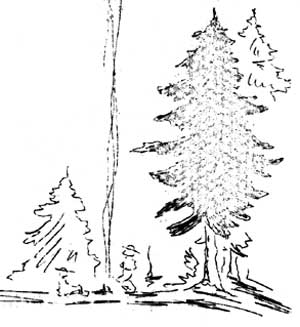
 | ||||||||
To the east the boundary of Mount Rainier National Park is hung from the summit of the Cascades - an addition of some 75 square miles in the spring of 1930. This region is traversed only by rudimentary trails for the purpose of protecting the area in case of fire and which served, in days past when this region was open to grazing, as a means of getting stock from one section to another. So, for the purpose of exploring this new park area and also in order that the timber type map of the park might be completed, the writer and Ranger-Naturalist Natt Dodge hiked along this eastern edge of the park in late September. We expected considerable that would be of interest and a lot of beautiful scenery. Yet we were not prepared for the many glorious panoramas that were laid before our eyes in all directions. The trail threads its way among numerous passes between the peaks of the Cascades -- first in the park and then in the National Forest which adjoins this area. And, being largely in the region above 5000 feet, we passed through numerous alpine meadows of superlative beauty. And the interest in the foreground was made additionally attractive by the spectacle upon the western horizon, for "The Mountain" in all its glory of ice mantled slopes and great ponderous bulk lifted its shining crest to the sky. Not too near so that its beauty was ruined by an improper perspective and not too distant so that the many familiar details on its immediate flanks were indistinguishable, it presented an imposing and wonderfully inspiring sight. The entire east side of the park lay at our feet like a giant relief map, the summits of the familiar Tatoosh Range to the south and to the north the Sourdoughs and other rugged ranges of that section. And we, seeking to catch such natural beauty with our cameras, reveled in the scene and, at the same time, bemoaned the inability of any lens to do it justice. Evening found us at a minature lake, the site of an old sheep camp just below the upper fringe of the forest. Soon the flickering light of our camp fire danced in the gathering gloom and the aroma of the evening meal mingled with the fragrance of the fir forest. All during the day we had seen great numbers of tracks of all kinds of animals - particularly those of deer, elk and coyote. And here on the shores of this minature lake we expected to have the opportunity of seeing possibly, one of the most beautiful sights that the woods at evening has to offer - an elk approach and drink from the motionless water of this alpine pool. But, unfortunately, we were disappointed. The evening hours were barren of such treats and the early morning hours found us completing our meal to allow an early start for the new day. Following the trail for several hours we noted places where animals had bedded down and tracks were equally as numerous as one the day previous. We soon deserted the trail however and dropped down through the dense timber of the mountain side toward Laughingwater Creek which was attained after considerable effort as the hillside was steep and our shoes soon became slick and slippery from the travel over the low ground cover. Laughingwater Creek is descriptive of this stream in every sense. Its clear, crystal water prattles over numerous boulders and rocky ledges as it threads its way through the dense forest toward the Ohanapecosh. First following along the bank, now splashing through the water of the stream we worked down the watershed, finally intercepting a narrow protection trail recently constructed by Ranger Barnett, of the Ohanapecosh District. 
It was not long thereafter that we had gathered about the dinner table in the Ranger Station where we enjoyed the hospitality of the Barnett's in an enjoyable meal and talked of the beauty of the region which we had traversed during the two days previous. Truly, the east side of Mount Rainier National Park offers as much of interest as any other section. Words cannot describe its beauty; pictures fall short of a true representation - one must see it to gain an appreciation of its charm. (C.F.B.) Click to see a copy of the original pages of this article (~112K) | ||||||
| <<< Previous | > Cover < | Next >>> |
vol10-11d.htm
17-Nov-2001